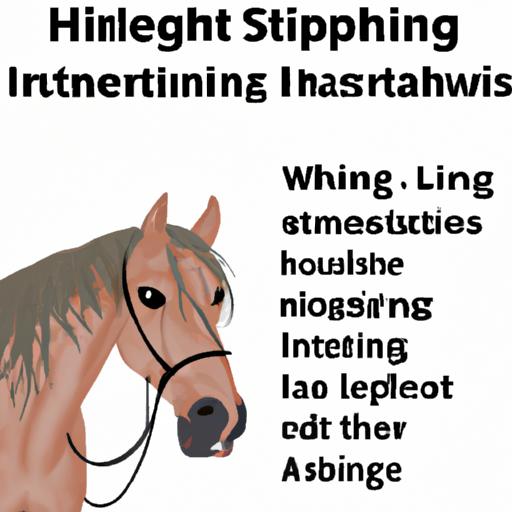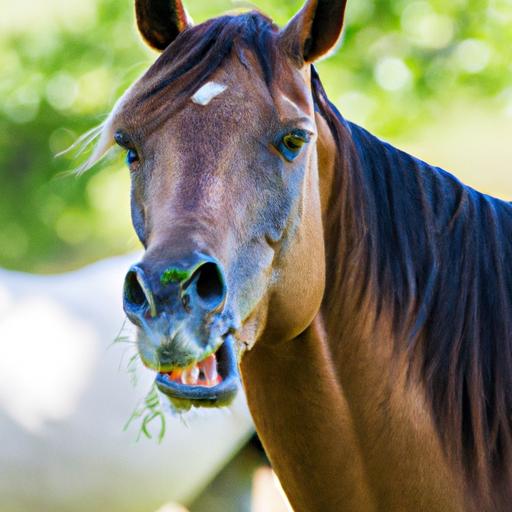Discover effective strategies for addressing and managing horse lip twitching. From veterinary care to behavior modification techniques, ensure your horse’s well-being.
Introduction

As horse enthusiasts, we know that understanding our equine friends is essential for their well-being. Horses communicate through their actions, and it’s crucial for us to identify any unusual behaviors they exhibit. One such behavior that often raises concerns is lip twitching. In this article, we will delve into the world of horse behavior and explore the intricacies of lip twitching in horses.
Overview of Lip Twitching in Horses
Lip twitching refers to the involuntary or deliberate movement of a horse’s lips. It can manifest as a subtle trembling or a more pronounced twitching motion. While it may seem like a trivial action, lip twitching can offer valuable insights into a horse’s overall well-being and state of mind.
Understanding the reasons behind lip twitching is essential for horse owners and caretakers. By recognizing and addressing this behavior, we can ensure our horses are comfortable and content.
Stay tuned as we explore the various causes of lip twitching, how to recognize the signs, and the steps we can take to manage and address this behavior. Let’s embark on this journey together and gain a deeper understanding of horse behavior and the intriguing phenomenon of lip twitching.
What is Lip Twitching in Horses
Definition and Description of Lip Twitching
Lip twitching in horses refers to the involuntary or intentional movement of their lips. It can manifest as a gentle quivering or a more noticeable twitching motion. This behavior involves the muscles around the lips and can occur intermittently or persistently.
Differentiating between Normal and Abnormal Lip Twitching
While lip twitching is a natural behavior in horses, it’s important to distinguish between normal and abnormal instances. Normal lip twitching typically occurs during moments of relaxation or while engaging in activities such as grooming. It is often characterized by mild movements and does not cause distress or discomfort to the horse.
On the other hand, abnormal lip twitching may be more intense and frequent. It can be indicative of underlying physical or psychological issues that require attention. Abnormal lip twitching may be accompanied by other signs of discomfort, such as restlessness or agitation.
Common Triggers for Lip Twitching
Lip twitching in horses can be triggered by various factors. Dental issues, such as sharp or misaligned teeth, can cause discomfort and lead to lip twitching as the horse attempts to alleviate the pain. Pain and discomfort in other areas of the body, such as joints or muscles, can also manifest as lip twitching.
Psychological factors, such as anxiety, stress, or nervousness, can contribute to lip twitching in horses. These emotions may arise from changes in their environment, social interactions, or training practices. Additionally, horses may develop habitual lip twitching as a learned behavior, mimicking the actions of other horses or responding to specific stimul
By understanding the definition, distinguishing between normal and abnormal lip twitching, and recognizing common triggers, we can better comprehend this behavior and take appropriate steps to address it. Let’s move forward and explore the reasons behind lip twitching in more detail.
The Reasons Behind Horse Lip Twitching
Physical Causes: Dental Issues, Pain, and Discomfort
One of the primary physical causes of lip twitching in horses is dental issues. Horses rely on their teeth for grazing and chewing, and any dental abnormalities or discomfort can lead to lip twitching. Sharp or uneven teeth, dental infections, or tooth root abscesses can all contribute to this behavior. Regular dental check-ups and floating procedures by a qualified equine dentist can help prevent and address these issues.
Pain and discomfort in other areas of the horse’s body can also trigger lip twitching. Musculoskeletal problems such as back pain, joint inflammation, or sore muscles can manifest through this behavior. Identifying and treating the underlying physical causes through veterinary care, appropriate medication, and therapies like chiropractic adjustments or massage can alleviate the need for lip twitching.
Psychological Causes: Anxiety, Stress, and Nervousness
Horses are highly sensitive animals that can easily experience anxiety, stress, or nervousness. These emotional states can manifest as lip twitching. Common triggers include changes in their environment, unfamiliar situations, or separation from herd mates. It’s crucial to provide a calm and secure environment, establish consistent routines, and gradually introduce new experiences to help reduce psychological stressors.
Behavioral Causes: Habitual Lip Twitching and Learned Behaviors
In some cases, horses develop habitual lip twitching or learned behaviors due to past experiences. They may have learned that lip twitching brings relief or attention, leading to a repetitive behavior. Similarly, if a horse has observed other horses exhibiting lip twitching, they may imitate this behavior. Addressing these behavioral causes involves behavior modification techniques, positive reinforcement, and redirecting their focus onto more desirable actions.
By understanding the various reasons behind horse lip twitching, we can take proactive steps to address the underlying causes. It’s important to consider both the physical and psychological aspects of our equine companions’ well-being to ensure their overall health and happiness. Let’s move forward and explore how to recognize the signs of lip twitching in horses.
Recognizing Signs of Lip Twitching in Horses
Horses have their unique ways of communicating, and lip twitching is one behavior that warrants our attention. By recognizing the signs of lip twitching, we can gain insights into our horses’ well-being and address any underlying issues. Let’s explore the different indicators of lip twitching in horses:
Physical Indicators: Muscle Movement and Facial Expressions
When it comes to identifying lip twitching in horses, paying attention to their physical cues is crucial. Observe for any involuntary muscle movements around the lips, such as trembling or twitching. These subtle motions can be indicative of lip twitching. Additionally, closely monitor their facial expressions for any signs of discomfort or tension.
Behavioral Indicators: Restlessness, Agitation, and Unusual Movements
Beyond physical indicators, behavioral cues can also provide valuable information about lip twitching in horses. Restlessness, agitation, or excessive movements, such as head tossing or pawing the ground, may accompany lip twitching. These behaviors may hint at discomfort or anxiety that your horse is experiencing.
Observing Lip Twitching in Different Situations
To better understand lip twitching in horses, it’s essential to observe its occurrence in various situations. Pay attention to whether the lip twitching happens during specific activities, such as grooming, saddling, or riding. Note any patterns or triggers that may be associated with the behavior. By observing lip twitching in different scenarios, we can gather more information to address the underlying causes effectively.
By being attentive to the physical and behavioral indicators of lip twitching and observing its occurrence in different situations, we can gain a comprehensive understanding of our horse’s well-being. In the next section, we will delve into the reasons behind lip twitching in horses and explore the potential causes.
Conclusion
In conclusion, understanding and addressing horse behavior, particularly lip twitching, is crucial for maintaining the well-being of our equine companions. By recognizing the significance of unusual actions and behaviors, we can ensure that our horses are comfortable, content, and in optimal health.
Lip twitching in horses can be indicative of various underlying causes, including physical issues, psychological factors, and learned behaviors. It is important to pay attention to the signs and observe the context in which the behavior occurs.
To address and manage horse lip twitching, several approaches can be taken. Veterinary examinations and dental care are essential to identify and treat any physical issues that may be causing discomfort. Pain management and medication can provide relief for horses experiencing pain or discomfort.
Behavior modification techniques, such as positive reinforcement training, can help redirect and reshape unwanted behaviors. Building trust and providing a safe environment are also essential elements in managing horse lip twitching. By creating a calm and secure space for our horses, we can help alleviate anxiety and stress.
At Horsemasterypro.com, we prioritize the well-being and welfare of horses. By understanding horse behavior, including lip twitching, we can ensure that our equine friends lead happy, healthy lives. Remember, effective communication and a keen eye for unusual behaviors are the keys to creating a strong bond with our horses.
So, let’s continue our journey of horsemanship, deepen our understanding of horse behavior, and foster a harmonious relationship with these magnificent creatures. Together, let’s unlock the secrets of horse behavior and provide the best care for our beloved horses.


